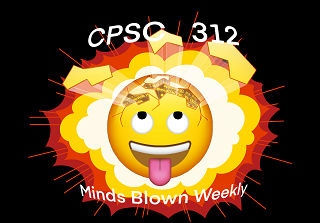Polymorphism and Higher-Order Functions
module Lecture4 where1 Abstracting Behaviour and Data
Let’s revisit SparseList, our data type for representing lists of Doubles without explicitly representing potentially long sequences of zeroes:
1.1 Review of SparseList
There’s nothing new in this section.
-- | A well-defined SparseList has a positive number of zeroes
-- in SkipAndRest cases. If a zero or negative value appears,
-- treat it as as a 1.
data SparseList = Empty
| OneAndRest Double SparseList
| SkipAndRest Int SparseList
deriving (Eq, Show)Here’s are some lists:
emptyL, twoEltL, manyEltL :: [Double]
emptyL = []
twoEltL = [0, 0]
manyEltL = [2.5, 1, 0, 3.2, 0, 0, 0, 1]Here they are as sparse lists:
slEmpty, slTwoElt, slManyElt :: SparseList
slEmpty = Empty
slTwoElt = SkipAndRest 2 Empty
slManyElt = OneAndRest 2.5 (OneAndRest 1 (SkipAndRest 1 (OneAndRest 3.2 (SkipAndRest 3 (OneAndRest 1 Empty)))))Here are functions to convert to/from sparse lists:
-- | Produces a regular list from a sparse list.
toList :: SparseList -> [Double]
toList Empty = []
toList (OneAndRest d rest) = d : toList rest
toList (SkipAndRest n rest) | n <= 1 = 0 : toList rest
| otherwise = 0 : toList (SkipAndRest (n-1) rest)-- | Produces a sparse list, but doesn't bother compressing
-- sequences of zeroes down. Just uses a SkipAndRest 1 for them.
fromList :: [Double] -> SparseList
fromList [] = Empty
fromList (d:ds) | d == 0 = SkipAndRest 1 (fromList ds)
| otherwise = OneAndRest d (fromList ds)1.2 A Couple of Concrete Functions
Now, let’s define two functions: slDouble doubles each element of a sparse list, slSquare squares each element of a sparse list. So, for example, doubling our sparse list that represents [2.5, 1, 0, 3.2, 0, 0, 0, 1] should result in [5.0, 2, 0, 6.4, 0, 0, 0, 2], whereas squaring it should result in [6.25, 1, 0, 10.24, 0, 0, 0, 1]. (Actually, because of the way Double arithmetic works, the result is off by a little bit, as in the test below.)
-- >>> slDouble Empty
-- Empty
-- >>> toList (slDouble slManyElt)
-- [5.0,2.0,0.0,6.4,0.0,0.0,0.0,2.0]
slDouble :: SparseList -> SparseList
slDouble _ = undefined -- >>> slSquare Empty
-- Empty
-- >>> toList (slSquare slManyElt)
-- [6.25,1.0,0.0,10.240000000000002,0.0,0.0,0.0,1.0]
slSquare :: SparseList -> SparseList
slSquare _ = undefined1.3 Abstracting Behaviour
Those two functions are very similar. Let’s abstract out the common behaviour into a function. Basically, where the functions have common behavior, we’ll keep it. Where they differ, we’ll build that difference into a function.
Think carefully as you go as well to see if we’re missing anything!
slMap :: SparseList -> SparseList
slMap _ = undefinedNow, let’s redefine slDouble and slSquare:
slDouble' :: SparseList -> SparseList
slDouble' = undefined slSquare' :: SparseList -> SparseList
slSquare' = undefined 1.4 Catching All the Cases
What about this function:
-- | Adds 1 to each element of a SparseList.
add1SL :: SparseList -> SparseList
add1SL _ = undefinedWill our slMap function handle it correctly? If not, what do we need to change?
Let’s go change it together. Then, I’ll have you define slFilter as an exercise.
(Two exercises!)
1.5 The Benefits of Abstraction
We can abstract out many common behaviours. Perhaps the most common are applying a function to each element of the list (mapping) and selecting only the elements of the list that pass some test (filtering, like grabbing only the positive elements or all the integer-valued ones).
Doing so:
- makes it easier for us to create new functions,
- focuses designers’ attention on making a small set of powerful abstract functions correct, efficient, and useful,
- refocuses our attention on the high-level task we want to solve rather than the details of its implementation, and
- makes it easier to adjust for different priorities in the future (like parallelism) .
Limiting side effects also makes it less likely that implementation details will “leak through” our abstractions.
Haskell supports a lot of abstraction!
2 Parametric Polymorphism
Our SparseLists really only work on numbers.1
But for regular lists, map and filter are defined in the Haskell Prelude for any type of list at all.
map :: (a -> b) -> [a] -> [b]: takes a function and applies it to each element of a list, collecting the results into a new list. Its type is alsomap :: (a -> b) -> ([a] -> [b]): taking a function on elements and turning it into a function on lists!filter :: (a -> Bool) -> [a] -> [a]: takes a test (a Boolean-valued function, also known as a predicate) and a list and returns only those elements of the list that pass the test.
Let’s rewrite some of our assignment functions to use abstract functions instead!
(Two exercises!)
2.1 Polymorphic Types
It’s not just functions that we might want to abstract, however, but types as well. In fact, a list is already a polymorphic type. Its data constructors ([] or “empty” and : or “cons”) can operate on any element type.
Let’s define our own. Imagine you wanted to redesign Haskell so that it maintained the “provenance” of all the values it computed: where they came from. You could create a data type that attached a textual description to each value, maybe allowing for both “commented values” and “plain values” that don’t yet have any provenance attached.
For Doubles only, that might look like:
-- | A "provenance value" for doubles, in two cases:
-- a commented value with a string comment describing provenance, and
-- a plain value with no provenance.
data ProValD = CVD Double String
| PVD DoubleBut we want to be able to represent any Haskell type. That means we don’t need a type like ProValD, we need something like a function that takes a type of value we want to represent and constructs a version of it that carries provenance around: a type constructor:
-- | A "provenance value", in two cases:
-- a commented value with a string comment describing provenance, and
-- a plain value with no provenance.
data ProVal a = CV a String
| PV aThis time, the first argument of each of our constructors can be any type!
The type ProVal Double behaves like ProValD above. When we define a polymorphic type, we list out its arguments (which are just lowercase identifiers) and then use them on the right to describe data constructors just like any type.
Here are some example values:
plainInt :: ProVal Int
plainInt = PV 7
commentedDouble :: ProVal Double
commentedDouble = CV 3.1415926525 "From IHOP"
proListOfString :: ProVal [String]
proListOfString = CV ["Four", "score", "and", "seven"] "Being raised in the US"
proProInt :: ProVal (ProVal Int)
proProInt = CV (CV 42 "The answer") "What do you get when you multiply.."Let’s define some functions that operate on ProVals. (Or, technically, they will operate on actual types, like ProVal a, ProVal b, or ProVal Char.)
(Three exercises!)
2.2 More Practice with Making/Using Types
Finally, we have a few more questions in the exercises to give you more practice with types.

